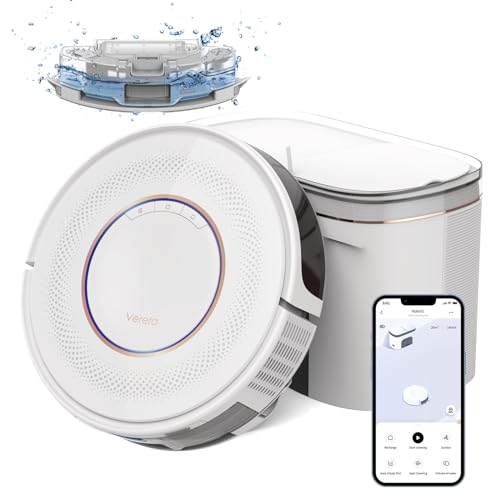
The Convenience of a Self-Empting Vacuum
Although the latest robotic vacuums are extremely quiet when they're being used, emptying them can be difficult. This is especially true when you have one that has a self-emptying base.
The bases come with docks that are connected to the robot vacuum and vacuums the debris into the large storage bin while charging it. This means that the robot vacuum's dustbin does not have to be cleaned every two or three cleaning sessions, but only once every 30 to 60 days.
1. Convenience
Although it might seem like it's lazy to let your vacuum empty itself but it's actually a wonderful convenience feature. The majority of robots have tiny dustbins that must be manually empty after each cleaning run, which can take time and limit the robot's ability to finish an entire room's worth of work in one session. A self-emptying vacuum has an incline that can automatically empty the dustbin when it's full. This will save you from having to bend down and empty the tiny bin.
Some models have a larger bin, which can hold up to a month of debris. Transferring the dirt from the bin to its base is typically quite fast and this can make it an ideal option for people who live in large homes or have pets that shed lots.
If you are thinking about a vacuum that self-empty be aware that they are generally more expensive. This is primarily due the fact that they come with an advanced base that has an additional function that goes beyond charging your robot vacuum.
It's not difficult to see however, it's important to note that self-emptying bases can be quite tall. This means that they may take more space than other bases, which could be a problem in smaller spaces or for those with limited storage space. The design of some self-emptying robotic vacuums can be an eyesore. It's not a deal breaker for most people, but it is something to consider for those who are concerned about the appearance of their home. The good news is, the majority of robot vacuums that
Best self empty robot vacuum-empty base look stunning. I've even had guests come by to praise my amazing piece of technology. Some may think that alone is enough to justify the price.
2. Less Allergens
Allergens are a major issue for many households, especially if someone in the household suffers from allergies. A self-emptying vacuum can reduce the amount dust pet dander, dust, and other allergens released into the air after vacuuming. You can be certain that all harmful particles will be sucked up into the bag and filter, instead of being released into the air. This can affect those with allergies.
If you'd like your vacuum cleaner to be more allergy-friendly, opt for one that has HEPA filtering. It also comes with various attachments that can be used for cleaning various surfaces. These vacuums are perfect for cleaning pet fur, textured crumbs, and other tough debris. This model also has a 25-foot cord and floor-to-ceiling cleaning reach.
3. Easier Maintenance
Having your robot vacuum automatically empty the dustbin at the base of the docking station is an enormous benefit. It stops the bin from overfilling, which self emptying robot vacuum is the
best robot vacuum and mop self cleaning (
inprokorea.com) could cause an obstruction that can cause your robot smell and stop functioning properly. It's also more clean to use the robot instead of manually emptying the trash. People who are allergic to dust can benefit from this since it stops allergens from being thrown back into the air. The Samsung Jet Bot+ comes with a large bin that can hold more debris than other
best budget self emptying robot vacuum-emptying robotic vacuums. This can help keep your floors clean for longer. The bin
what is the best self emptying robot vacuum equipped with a built in filter that can capture pet hairs, dirt and other tiny particles. This makes it easier to clean and less likely to overfill than other self-emptying robots.
4. A Shorter Time
For those who struggle with a busy schedule self-emptying robots can be an absolute game-changer. They allow you to complete more cleaning without needing to be physically present. They also empty the dustbin at the end of every cleaning session. This allows you to spend less time on chores and spend more time taking a break or doing other activities.
Regular robot vacuums typically come with a small bin or dustbin which is designed to hold the accumulated dirt and debris it accumulates after each cleaning cycle. When you empty the dustbin you are exposed to all the nasty stuff that was kicked into the air. You may have to clean it by hand before you are able to use it again. In 2018 the first self-emptying robot vacuum cleaners were introduced. When the bin of a self-emptying vacuum is full it returns to its docking station and connects to the base station. The dust and debris are then removed from the bin by the sound of a base canister that is about a foot tall which is equipped with a disposable bag. The vaccum then recharges its battery and then returns to its pre-programmed path.
Manufacturers usually rate the canister bags to store debris for 30-60 days. This means you'll have to empty the base station approximately once or every month, based on how much you clean and how filthy your floors get. This is a huge time-saver in comparison to emptying the dustbin after each cleaning session of robot vacuum. You are also exposed to fewer allergens more frequently.

A self-emptying robot can also reduce time by removing the necessity of replacing the filter. We've all done it at least once. It can also prevent issues such as over-stuffing or blockages, which could cause the performance of your robot to be affected.



